Archives
Archives
Welcome to the Gallery. Here you will find archives of artwork, photos, news clippings and press releases.
Photos
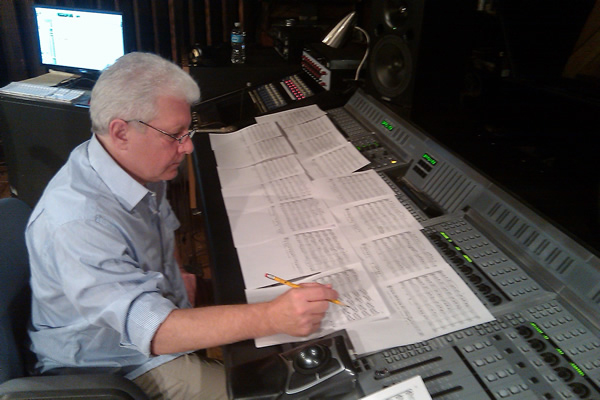
News, Press, and More...
Here we have a collection of news clippings, press releases and more.
Bob performed Sunday, September 22, 2013 at the Nuyorican Poets Cafe
Bob was recently mentioned in these three books:

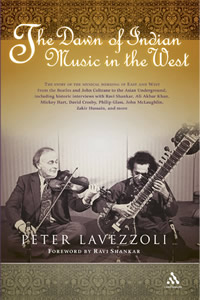
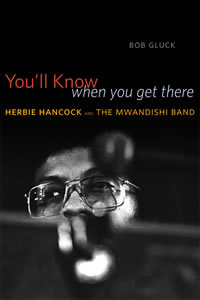
Machine Gun | Bill Laswell | Lunar Bear Ensemble | Thomas Chapin
Robert Musso | Improvised Music New York 1981 |
Pheeroan Aklaff | Last Exit | Lance Carter
Downtown Music Gallery Reviews
BOB MUSSO & FRIENDS [with RAOUL BJORKENHEIM/ELLIOTT LEVIN] - 3
Performances: Media Bureau Network, Black Lodge & DMG Bowery Benefit +
Interview [DVD-R] (MuWorks DR; USA) This long DVD features three
complete performances by guitar ace, producer & engineer Bob Musso and
his great evolving cast of fine musicians, from three different sets in
2007 and 2008. The Media Bureau Network (12/29/07) in Philly featured
Bob on guitar, Elliott Levin on saxes, flute & poetry, Dave Driewitz on
bass and Claude Coleman on drums, a/k/a The Transonic Band. The DVD
intersperses short interviews with each member of the band about who
they are and what they do. This is a strong, spirited and tight
jazz/rock band performing songs from Bob's great 'Inner Medium' CD on
DIW, as well as some choice covers. This set is well captured in a
multi-camera shoot, a most intimate portrait of a great quartet. Bob
switches off between a few different guitars and takes some superb
solos. I dig that bittersweet sustained tone on the second piece. One
of Philly's finest and busiest musicians in Elliott Levin. He plays
with consistent fire and immense creativity whether on tenor or soprano
saxes, flute or performing his crafty poetry. He takes a number of
inspired solos throughout and is Bob's (no-so-secret) weapon.
The second performance was filmed at Black Lodge, also in Philly on
9/27/08 with Bob, Elliott, Dave and a different drummer, Eric Slick.
Again, the quartet is in fine form: tight, spirited and often on fire!
The rhythm team is especially killin' on this set with Dave Driewitz
(from Ween) on electric bass and Eric Slick (Adrian Belew Band) on
drums. Both Bob Musso and Elliott Levin continue to slay us with a
number of astonishing solos. Once again the multi-camera shoot captures
the band in all of its glory. If you want to see and hear some glorious
jazz/rock at its best, this is the perfect remedy. The quartet also
plays a freer piece which is also great, spooky at times with superb
flute from Elliott and cerebral guitar from Bob. It is Elliott's poetry
that really pushes things to the top.
The final performance was filmed at Bowery Poetry Club on December
17th of 2008 for a benefit gig for our store which was being forced to
relocate. For this set Bob & Friends added our pal & guitar great Raoul
Bjorkenheim, just back in town for a bit, and at my suggestion another
old friend, Keith MacSoud on bass. With not one but two daredevil
guitarists, the band is even hotter than before. Both Bob and Raoul
trade amazing solos throughout this truly incredible set. Although
there was only minimal rehearsals, Keith & Eric lock in together and
play asif they have been at it for years. The band consistently
outdoes itself with tight, intricate and creative leaps and bounds. For
fusion fans around the world, this set is for you! Raoul plays some
totally cosmic slide guitar on the first piece while Mr. MacSoud wails
on electric bass - whoa! This set is looser yet it works especially
well since there is such a communal, free-spirited vibe that runs
throughout. There are too many amazing solos to describe here but I
have to admit that I was very proud to have this outstanding band play
for DMG's benefit. For those of you who haven't taken the plunge into
buying DVD's this is good enough reason to start here since it doesn't
get any better than this. For those of you that are buying DVD's, you
need this one for your collection. It is hard to beat. - Bruce Lee
Gallanter, Downtown Music Gallery
DVD $16
Bob & Friends 2009 CD Releases
Former leader of the legendary and explosive Machine Gun band (with Thomas Chapin), head of MuWorks records and engineer & assistant to Bill Laswell for hundreds of sessions, Robert Musso, is a restless spirit, a talented guitarist, bandleader, engineer and producer. Over the past few years Bob has put together a new band with a revolving cast of great players and has been playing in the tri-state area. Bob is wise enough to record each set and has released a half dozen gem so far. The next batch has just arrived and again Bob has pulled more rabbits out of multi-colored hat!
BOB & FRIENDS [ROBERT MUSSO With RAOUL BJORKENHEIM/ELLIOTT LEVIN/KEITH MacSOUD/ERIC SLICK] - Bowery Benefit (For Downtown Music Gallery) At The Bowery Poetry Club - December 17 2008 (MuWorks 66 CR; USA) Ltd Ed CDR. This set took place last December at a benefit for us, DMG, with Bob & Friends playing in-between Tisziji Munoz and the Elliott Sharp Power Trio. It was an extraordinary night and the proof is in the pudding, so starting savoring... The newest addition to this quintet was/is bassist Keith MacSoud, an old friend of mine (& bandmate w/ Elliott Levin) who I suggested to Bob and fit perfectly, adding some special spice to an already amazing group. To those of you who need that their fusion fix, all of Bob's bands show that great fusion is still happening! Both Bob and Scandinavian legend, Raoul Bjorkenheim, trade series on amazing guitar solos and work so well together. Young drum wiz, Eric Slick, is currently playing with Adrian Belew and both he and Keith are one of the best, most creative and inspired rhythm teams around. Not bad considering that this was their first gig together. Philly legend, Elliott Levin from New Ghost, plays strong tenor sax, flute and is one of the best poets/speakers around. Elliott always adds a certain bohemian magic to any project he is involved with and recently has been getting more exposure/recognition thanks to ESP & Porter Records. The free parts of this set are actually, tight, focused and never superfluous. Now that I don't have to MC, I can sit back, relax and enjoy another treasure from Bob Musso & Friends. - Bruce Lee Gallanter, Downtown Music Gallery CD $12
Bob & Friends - DMG 16th Anniversary at the Bowery Poetry Club
BOB & FRIENDS [ROBERT MUSSO With RAOUL BJORKENHEIM/ELLIOTT LEVIN/DAVE DREIWITZ/JOHN 'LUNAR' RICHEY/ERIC SLICK] - DMG 16th Anniversary At The Bowery Poetry Club - September 22 2007 (MuWorks 60 CR; USA) Ltd Ed CDR. Wow! Despite the fact that yours truly did the on-stage intro to this set, listening back to it now, it sounds truly f**king amazing! This not just jam session, this band has obviously rehearsed and is playing mostly original material by Machine Gun head, Bob Musso, as well as a couple of well-chosen covers, like that great Sonny Sharrock song at the end of the set. - Bruce Lee Gallanter, Downtown Music Gallery CD $12
All Machine Gun posters were created by Dave Goldin.
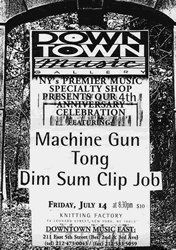 Machine Gun Reviews
Machine Gun Reviews
The Source, Machine Gun – Pass the Ammo: You’ve read the story in the paper: “Man Goes on Shooting Spree in Local Shopping Mall.” Well, now you can buy the sound track: Machine Gun’s Pass The Ammo. Yes, in the comfort of your own home you can finally hear the kind of sounds that probably fly through the head of a madman as he opens fire on helpless shoppers! In fact, this CD is (I’ve never used this word in a review before, so listen up) downright maddening! – While listening to this CD I’ve contemplated all sorts of wild stuff, from simply taking a sharp turn into a lamppost to shaving my cat with my teeth. Forget lyrics, Tipper, this stuff should require a License of Stable Sanity; parental guidance just isn’t enough. – But don’t go out and buy a bulletproof vest just yet, kids, because most people, sane or not, probably won’t last through this CD. It’s a frenzied trip along semi-freeze jazz (mega-improvised variety) lane, and few listeners have the patience to listen long enough for the insanity to truly infect the mind. If you are one of the strong, stable, comfortably sane (color that phrase with a few ounces of subjectivity), then listen carefully. – Starting with “Seethe,” you’ll hear the mind’s sounds as our resident madman opens fire. Then with “Trance/Formation,” you’ll lie awake with this madman as he stares at the shadows dancing on the ceiling and tries to understand their words. Later, in “Court Jesters,” you’ll take a jog through the park, attacking the flowers that mock you and shout at the birds because they try to suck the air out of your lungs. When you finally keel over, gasping for breath, you catch a glimpse of the angels coming for you, but the police scare them away. Finally, you check the tightness of your new jacket in “Brighton Brawl” and “To Be Continued,” and wonder what kind of insect you want for dinner. – All of this with pounding drums, persistent cymbals, thundering dissonant bass, a guitar that’s doing things that are probably illegal in some states, a saxophone that bounces around harsh notes that don’t care who they insult, a flute that teasingly hints at sanity, and to top it all off, there’s even some vocal stuff that, according to the liner notes, are from tapes and television (their purpose is probably to complete the whole picture of madness with voices in your head). – Get this CD before it gets you. Just leave your gun unloaded. – By Ted Kusio.
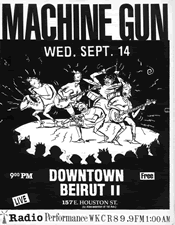 Genesis, Machine Gun: 21st Century Jazz: Everything old is new again, or so we’re told, and through this New York-based quintet, led by guitarist/bassist/studio whiz Robert Musso, has obvious antecedents in such free-jazz improvisational groups as Last Exit and experimental congregations such as Throbbing Gristle, Machine Gun’s brand of punk jazz is both technically brilliant and emotionally overwhelming. Generalist John Richey provides a unique and spontaneous layer of found noise, cutups and television transmissions- as they occur. Their first, self titled album is available on MU Records.
Genesis, Machine Gun: 21st Century Jazz: Everything old is new again, or so we’re told, and through this New York-based quintet, led by guitarist/bassist/studio whiz Robert Musso, has obvious antecedents in such free-jazz improvisational groups as Last Exit and experimental congregations such as Throbbing Gristle, Machine Gun’s brand of punk jazz is both technically brilliant and emotionally overwhelming. Generalist John Richey provides a unique and spontaneous layer of found noise, cutups and television transmissions- as they occur. Their first, self titled album is available on MU Records.
Pulse, Machine Gun - Pass The Ammo: Sonny Sharrock’s distortion-laced shards-of-splintered-glass approach to guitar is an obvious influence on Robert Musso. And Thomas Chapin’s approach to alto sax seems heavily indebted to Sun Ra’s resident squeakophonics master, Marshall Allen, particularly on the aptly titled “Seethe” and on “Court Jestures.” Between the faux jazz of “Wind vs. Steel” and the sonic drano of “Cybercat,” this is some pretty frightening stuff. Throw in the wacky vocal cut-ups of tape manipulator John Richey and you’ve got one very sick improvisational noise ensemble. Dinner music for Hannibal Lectore. – By Bill Milkowski – April 1993.
 Spin -Underground, Machine Gun: Got nothing approaching real info on Machine Gun, but I’ve heard that they’re from New Jersey, and I can testify that their debut LP, Machine Gun, is one of the most shit-hot pieces of group improv I’ve heard in a while. The basic quintet (winds, percussion, bass, guitar, tapes) is wonderfully augmented on this disk by the iron-angular guitar of Sonny Sharrock and ethereal melodica of Karl Berger (both of whom are big-time free-jazz legends). The 10 improvised tracks here are short enough to not overwhelm casual listeners and can compare real favorably with any recent New York hub-bub. And thankfully, Machine Gun seem to eschew the funk base that keeps many of their contemporaries from combusting as fully as they might. The few debts that they do owe are to people like Ornette (a horn part here) or Ayler (a ghost march there), and influences like that are always appreciated. Drawing mostly from their own souls, though, Machine Gun have created a not un-swinging burst of sonic fire that can knock you down as easily as an oxen. Open up and say, “Moo,” baby. – By Byron Coley.
Spin -Underground, Machine Gun: Got nothing approaching real info on Machine Gun, but I’ve heard that they’re from New Jersey, and I can testify that their debut LP, Machine Gun, is one of the most shit-hot pieces of group improv I’ve heard in a while. The basic quintet (winds, percussion, bass, guitar, tapes) is wonderfully augmented on this disk by the iron-angular guitar of Sonny Sharrock and ethereal melodica of Karl Berger (both of whom are big-time free-jazz legends). The 10 improvised tracks here are short enough to not overwhelm casual listeners and can compare real favorably with any recent New York hub-bub. And thankfully, Machine Gun seem to eschew the funk base that keeps many of their contemporaries from combusting as fully as they might. The few debts that they do owe are to people like Ornette (a horn part here) or Ayler (a ghost march there), and influences like that are always appreciated. Drawing mostly from their own souls, though, Machine Gun have created a not un-swinging burst of sonic fire that can knock you down as easily as an oxen. Open up and say, “Moo,” baby. – By Byron Coley.
Option Magazine, Machine Gun: Back when the early Material albums came out, this would have been called “punk jazz.” Machine Gun is a five-man improvisational band, here recorded live, produced by Robert Musso (long-time engineer for Bill Laswell), who also plays guitar and six-string bass. The other members are saxophonist/flutist Thomas Chapin, drummer Bil Bryant and electric bassist Jair-Rohm Parker Wells (who play together in a Swedish group), and poet/tape manipulator John Richey. Guest musicians Sonny Sharrock (guitar) and Karl Berger (melodica, voice) appear on half the tracks. The general approach is to lay down a ferocious rock groove, spice with some outside solos and voice tapes, and stir into a frenzy. This band does tend to drive with its pedal to the metal – the noise level is high, but so is the creativity. When Sharrock and Berger join in for the second half, the solos are hottest, but Chapin’s playing is notable throughout, and Richey contributes an ongoing criminal law lecture. A good reminder (if a little extreme) of what jazz rock fusion was supposed to be about. - By Mark Sullivan.
 High Fidelity (Vol. 39 No.5), Machine Gun – Machine Gun: Machine Gun plays untamed fusion, which is to say what fusion might sound like if it had developed along lines to true to the expressive prerogatives of the music rather than according to the dictates of the marketplace. Basically a guitar-sax-bass-drum combo with occasional flute and taped vocal miscellany (including so-so poetry), the group conveys a continual sense of urgency, of crisis being lived through- sometimes rhythmically hyped (“Fancy Products” and “Prancing in Your Bed,” the latter a reworking of Ornette Coleman’s “Dancing in Your Head” theme), sometimes describing a more broody landscape, lunatic and abandoned to fester (“Dive,” “Trinity Rain”). The intensity is upped a notch during the second half of this Compact Disc, with guest Sonny Sharrock: His corrosive guitar cussin’ over the 3-D bump and grind of “Muffy’s 1st Date” is especially fine. Hot trax for avant-raunch devotees. – By Richard C. Walls. - May 1989
High Fidelity (Vol. 39 No.5), Machine Gun – Machine Gun: Machine Gun plays untamed fusion, which is to say what fusion might sound like if it had developed along lines to true to the expressive prerogatives of the music rather than according to the dictates of the marketplace. Basically a guitar-sax-bass-drum combo with occasional flute and taped vocal miscellany (including so-so poetry), the group conveys a continual sense of urgency, of crisis being lived through- sometimes rhythmically hyped (“Fancy Products” and “Prancing in Your Bed,” the latter a reworking of Ornette Coleman’s “Dancing in Your Head” theme), sometimes describing a more broody landscape, lunatic and abandoned to fester (“Dive,” “Trinity Rain”). The intensity is upped a notch during the second half of this Compact Disc, with guest Sonny Sharrock: His corrosive guitar cussin’ over the 3-D bump and grind of “Muffy’s 1st Date” is especially fine. Hot trax for avant-raunch devotees. – By Richard C. Walls. - May 1989
Guitar World, (Vol. 9. No. 11), Machine Gun – Machine Gun: These are some sick motherfuckers. Guitarist Robert Musso has gained some renown as producer Bill Laswell’s right-hand man, having engineered at least a dozen of the big budget, major label projects that Laswell’s presided over in the past four years. Machine Gun is Musso’s chance to step away from the mixing console, strap on a guitar and flail away. And with special guest Sonny Sharrock adding to the free-for-all bombast, this record is dangerously intense at peak moments. Not at all recommended for New Age devotees, Tracy Chapman or Suzanne Vega groupies or anyone with a heart condition. Purely an improvisational affair captured live at two separate gigs (the Court Tavern in New Brunswick, New Jersey, and CBGB’s in the heart of Manhattan’s Bowery.) Machine Gun rambles from track to track, upsetting conventions along the way. The “tunes” begin, and after much thrashing, somehow manage to end, almost magically. There are ten such improve sections on this disc, some more intriguing than others. Sharrock lends his inimitable mind-blowing sound (a Les Paul through a Marshall stack with Heavy Metal pedal) to the free-form proceedings on side two. Musso scratches, scrapes and bites the strings throughout, augmented by Thomas “Rage” Chapin’s screaming sax work. Jair-Rohm Parker’s bass and Bil Bryant’s drums. Tape-manipulator John Richey adds his own sonic seasoning to the dense mix and New Music maven Karl Berger plays melodica on a couple of cuts. – This is kind of reminiscent of the early Frith-Kaiser improv stuff, harkening back to the early eighties. It’s outrageous and slightly psychotic in the tradition of Laswell’s Last Exit band – if that’s your cup of tea. – by Bill Milkowski. – December 1988.
CMJ – New Music Report, Machine Gun – Pass The Ammo: Machine Gun is a musical cyclotron, a free-jazz particle accelerator. On Pass The Ammo, the band has fully grasped control over the jazz/noise throne recently abdicated by Last Exit, and like that Jovian quartet, it is continually mapping out new zones and unexplored terrain, finding new sounds in places where it was once thought music couldn’t go. The stock of the Machine Gun is the rhythm section of bassist Jair-Rohm Parker Wells and drummer Bill Bryant, its barrel is Thomas Chapin’s haunting flute and saxophone work, and guitarist Robert Musso is its triggerman, his actions and reactions spurring the rest of the group to heights of improvised explosiveness. John Richey’s vocal cut-ups, sound bites and tape manipulations add an extra layer of intensity on top. Check the tracks like “Seethe” and “Trance Formation,” or try the full throttle jams of “Brooklyn Brownout” to hear the band making a less than joyful noise. Also note the cartoonish black humor on “Court Gestures,” where Chapin’s birdlike flute is crushed, Bambi Meets Godzilla-style, under the humongous weight of Musso’s guitar, in a sense a very real and modern descendent from the music of Carl Stalling (or Raymond Scott, see lower left). Play at your own risk – hard had, sandbags and flak jacket not included in the CD booklet. – By James Lien, November 20th, 1992.
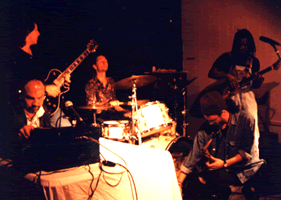 Musician, New Release Reviews: Jazz, Machine Gun – Pass The Ammo: These New Yorkers treat cacophony like a public space – Yankee Stadium, say – where everything’s allowed to come and go. That’s why it’s somewhat surprising their rattletrap spew manages to way coherent. What helps put musicianship into the fairly predictable fray is the way that Bill Bryant negotiates his pummel/swing exchanges. Backbeat never hurt anything in this frenzied realm, and because of rhythm, Robert Musso’s blurry extrapolations clobber complacency as keenly as Tom Chapin’s (Evan) Parkeresque oinking. That makes us forgive their Pangaea delusions. – By Jim Macnie, March 1993.
Musician, New Release Reviews: Jazz, Machine Gun – Pass The Ammo: These New Yorkers treat cacophony like a public space – Yankee Stadium, say – where everything’s allowed to come and go. That’s why it’s somewhat surprising their rattletrap spew manages to way coherent. What helps put musicianship into the fairly predictable fray is the way that Bill Bryant negotiates his pummel/swing exchanges. Backbeat never hurt anything in this frenzied realm, and because of rhythm, Robert Musso’s blurry extrapolations clobber complacency as keenly as Tom Chapin’s (Evan) Parkeresque oinking. That makes us forgive their Pangaea delusions. – By Jim Macnie, March 1993.
Rolling Stone: On The Edge, Machine Gun – Open Fire: Machine Gun may sound like the name of a tenth-rate Metallica imitation, but this New York- based quintet plays a whole other kind of heavy metal. Open Fire (MU New York LP, cassette and CD with extra tracks) is a punk-jazz noisefest a la Last Exit by way of mid-Seventies Miles Davis and Ornette Coleman’s Prime Time (guitarist Sonny Sharrock, formerly with Last Exit and Davis, appears on three tracks). The material is all live and improvised, with guitarist Robert Musso and saxman Thomas Chapin kicking serious free-form booty. Musso has also released an instrumental solo album, Absolute Music (Mu New York LP, cassette and CD), which is more meditative, but no less hair raising… By David Fricke.
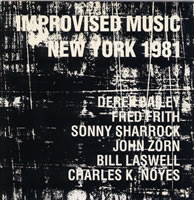 Improvised Music New York 1981 – Review
Improvised Music New York 1981 – Review
Pulse, Number 102 – Derek Bailey, Fred Frith, Sonny Sharrock, John Zorn, Bill Laswell and Charles K. Noyes – Improvised Music New York 1981: In free-jazz terrain, Improvised Music New York 1981 is an unburied treasure and, quite often, an unbridled terror. Recorded in the last days of the old Kitchen performance space in New York, the album contains a performance by an early lineup of Material, bassist/producer Bill Laswell’s legendary group for whom eclecticism was a virtue. Material laid much of the groundwork for the downtown scene’s dissonant textures in the years to come. It brings together then-emerging enfants terribles Laswell, guitarist Fred Frith and alto-sax mutilator John Zorn, as well as percussionist Charles K. Noyes and generation-older guitar masters Derek Bailey and Sonny Sharrock. The result? A clanging, skreeing and skronking chamber-of-horrors performance. – Full of vicious spontaneity, ugly ambience, violent guitar slashes and brutal horn blasts, Material’s performance that night is a hodge-podge of auteurs turned savages chucking rocks at each other: the sort of discordant noise that’s been funneled down through the New York noise pantheon in years since, picked up form the likes of internationalist Peter Brotzmann and Glenn Branca, funneled through the maelstrom of Sonic Youth, and handed down to the likes of Pussy Galore and, most recently, Helmet. Of course, in ensuing years, Zorn has become the jazz world’s foremost cultural terrorist, amping the feral fusion he toys with here into the full-scale noise holocausts of Naked City, Painkiller, et al. It’s a New York, Lower East Side kinda thing, dig? – As an archival piece and portrait of the early 80’s downtown underground – particularly for the uninitiated- Improv is essential. As a work-out in the possibilities of improvisation and machine-gun feedback, it’s loaded with plenty of moments of wonderfully improvised pain. Forget the dreadful dub-groove of Material’s latest, The Third Power (Island/Axiom). Ten years ago, Laswell & Co. didn’t have an iota of patience for lightweight disco records. – Mike Gitter, March 1992.
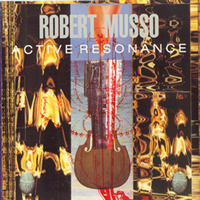 Robert Musso -
Robert Musso -
Active Resonance -
Review
Billboard, Volume 104 No. 8, Robert Musso – Active Resonance: Progressive, highly enjoyable jazz/rock/funk exploration showcases composer/guitarist Musso (who also plays a host of other fretted instruments), as well as other topnotch players Thomas Chapin on reeds, Jonas Hellborg on bass, and Material boys Bernie Worrell and Bill Laswell. With a solo style that’s highly changeable and universally ravenous, Musso gets muscular with great, well-wrought rock instrumentals like “A Dream Supreme,” “Alliance,” and “Ancient Silk Road,” as well as funky themes “Amu Darya,” “The Squidge,” and a raga-fied “Tamari.” Bootsy Collins does a brief cameo vocal on “All Funked Up.”
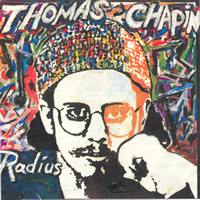 Thomas Chapin Review
Thomas Chapin Review
CMJ, New Music Report, Thomas Chapin- Radius: The first release by Chapin’s Radius Quartet burns throughout its 50-minute duration. Backed by stellar players such as bassist Ray Drummond, pianist Ronnie Mathews and drummer John Betsch, Chapin delivers an invigorating, strong, straight-ahead program. Chapin brings all his musical experience – he was the music director of Lionel Hampton’s Big Band from ’81-’86, as well as collaborating with Chico Hamilton, cellist Jane Scarpatoni, bluesman “Gatemouth” Brown, to name a few – into clear focus. All tunes were composed by Chapin with the exception of his eloquent rendition of Fats Waller’s “Jitterbug Waltz.” Chapin, aside from having an astonishing command of both flute and alto saxophone, also possesses an individual voice on both instruments, a commendable trait these days, especially when many young players seem to disregard the virtues of developing one’s own sound. The ever-so-underrated bassist, Ray Drummond, shines throughout Radius; also, pianist Ronnie Mathews’ playing is nothing short of spectacular, anchoring the whole band with grace and fire.
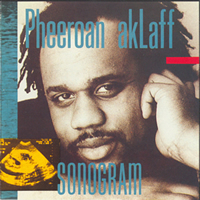 Pheeroan Aklaff Review
Pheeroan Aklaff Review
CMJ, Pheeroan Aklaff - Sonogram: Percussionist Pheeroan akLaff has long been held in great respect amongst those in the know in the world of jazz percussion. On Sonogram, he stretches out musical and structural blueprints, filled in melodically with help from his supporting cast of players, an enviable list of raw talent including Sonny Sharrock on guitar, John Stubblefield on tenor saxophone, Carlos Ward on alto and Kenny Davis on bass. At the center of gravity of this volatile combo, we find akLaff anchoring the pulse in a variety of rhythmic modes, deftly imbuing his playing with both electricity of the brain and blood of the heart. Tracing a lineage of drums all the way back from Gene Krupa and Max Roach on to Art Blakely and into the present , akLaff’s playing often approaches a more restrained version of Roland Shannon Jackson’s attack, with akLaff either brutally pounding his skins into submission or caressing them into dense and brisk layers of subtly interplayed rhythmic expression. Whether rippling through Miles Davis’ “Tout De Suite,” rumbling though original compositions like “Bit Her” or “Juggler,” or stretching out solo on the title track, Pheeroan akLaff and his men play uncompromising music that pulls jazz to the highest levels of artistic endeavor.
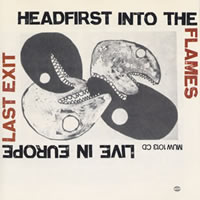 Last Exit - Review
Last Exit - Review
i/e, Last Exit – Headfirst Into the Flames: Much more assaultive than one might expect from the four grandfatherly jazzmen who make up Last Exit, Headfirst Into the Flames, recorded live in Stockholm and Munich in 1989, presents the band at its best. Ex-Ornette Coleman drummer Ronald Shannon Jackson and bassist Bill Laswell seem to shift rhythms telepathically, constantly slipping from one ominous mood into another. Their rhythm work is engaging even without the solos of saxman Peter Brotzman and recently deceased guitarist Sonny Sharrock. Add Brotzmann’s squeals and guttural honks to Sharrock’s ‘how’d-he-do-that’ guitar slaughtering, and you have the best noise-jazz to be found. Listen no further than the first cut, “Lizard Eyes,” for proof of how involving their brand of discordant machismo can be. No less than any conservative be-bop group, the members of Last Exit know how to play together. Unlike lesser noise bands, no grandstanding or competition occurs here: when Sharrock or Brotzmann solos, the other dutifully support in their own raucous voices. Tasteful cacophony is not an oxymoron for this band. – By Dave McElfresh, Summer 1994.
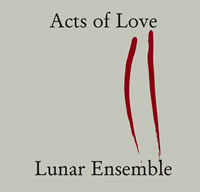
ARTS WEEKLY DECEMBER 24, 2008
back to top
Shoreworld by John Pfeiffer
Lunar Ensemble — Acts Of Love
Acts Of Love is the latest offering from New Jersey avant guardians Lunar Ensemble. Utilizing famed producer Robert Musso (Tom Waits) the Lunar crew have once again come up with an interesting 10-song winner. “Dreaming Of Tamara” comes right at you, mandolins and strings creating the musical vibe of Scar Face Cojones mixed with a dangerous rattlesnake hum in the dusty world of the Mexican cowboy. John Richey slides in with his unique spoken lyrics,with a dry and compressed style that reminds me of John McCrea (Cake), his energetic monotone pushing the sax into the foreground. Ah, Tamara on that red velvet couch with luscious legs. As John says, I’m dreaming of Tamara.
“Cultured Mannequins” starts in a rambling loose build featuring echoed slide work that would make the Edge stick his envious nose in the air and go “Hmph!” Once again the band sets up spoken word like no one else. John deadpans, “The universe, falls on me like cold iron” as the orchestrated chaos reigns down ala bass and drums, perfectly framed wah wah’s and lush supporting horns, all diving deep at their creative mark like a Japanese fighter pilot hitting a destroyer.
“Hitchhiking Dark Cliffs” hits you with an alt-kiltered rock feel, settling down into Richey’s cool lyrical lines and the guitar payer’s dark, steel-bending runs. Good use of bridge work here. As clever as the lyrical content gets, the band talks right along side Richey with scary communicator skills.
One of my favorite cuts is “The Departure,”an echo-tinged Curtis Mayfield guitar jam, bouncing along wetly with reverbed drenched chords and splashing against solid chorused Tom DiEllo bass and dynamic Chris McKenna drumlines. John shoots from the hip with lines like “I’min my wheelchair…fatigued, having wrestled with my nurse on the bare wooden living room floor.” Richey always keeps the listener on point and thought-provoked; feeding them fascinating content throughout this entire thinking man’s record.
With players like Dave Dreiwitz (Ween) on coronet, flute and percussion and Chris McKenna, Tom DiEllo, Doug Slugger Vitzhun, guitars, Greg D, guitar, and even Robert Musso on the sitar, you can’t find a better caliber of killer pro’s to back Richey’s spoken word. This disc demonstrates a band with a monster tight grasp on their musical branch that allows Lunar’s mind to flow freely with wild, wild verse.
Acts Of Love is a well-produced gem that’s worth picking up when you see it available. With the production of Musso and the mastering of Asbury Media’s Tom Ruff, the sound and feel of this disc is top-notch luxury. Also according to Richey, the CD offers a musically historic bonus with the re-releasing of two singles from his Young Turks days, “Cultured And Acoustic Mannequins,” as listed above, and a duet with the phenomenal John Petruzelli (Joan Osborne,Patti Smith.) For further information on the new project and to download some free songs, head over to myspace.com/lunarensemble.
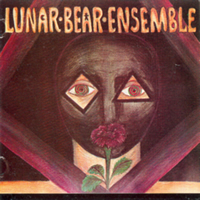 Lunar Bear Ensemble – Reviews
Lunar Bear Ensemble – Reviews
CMJ , Lunar Bear Ensemble - (self-titled): Producer/mixer/engineer Robert Musso, who has collaborated extensively with Bill Laswell on varied projects such as PiL, Tom Waits, Miles Davis and the Ramones, has found an interesting ensemble to land his hands and ears on. The Lunar Bear Ensemble’s main frame is vocalist Lunar (John Richey) and percussionist Bear (Richard Graham), the former being a founding member of the band Machine Gun and the latter a poet/ethnomusicologist who has studied extensively with Glen Velez. The music may strike you as a reggae/funk/hard-edged-rock/King Crimsonish kind of sound, whereas John Richey’s vocal style is fairly reminiscent of Adrian Belew’s vocal work on Crimson’s Beat album, his lyrics are both distinct and poignant. Drummer Martin Atkins- who has worked with PiL, Jah Wobble and Brian Brain- provides a jumpy go-go/hardcore-ish groove throughout the whole record and guitarist Eddie Freeze provides a natural scorching sound, complimenting the whole tone of this project. Some tunes that particularly stand out are “Musiclal Fatale,” “Bleeding Liberal” and the berimbau and mandolin laced “Corner of George.”
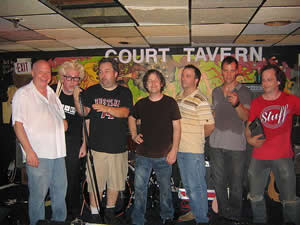 Rockpool, Lunar Bear Ensemble - (self- titled): A cornucopia of dislodged thoughts and emotions are explored by the Lunar Bear Ensemble, but none more evident than all-American angst. Merging a Ginsberg-inspired poetic conviction with the dented tenets of free jazz/fusion, the lead singer’s strident vocals bang against a cacophonous wall of sax and guitar that is pliable yet impenetrable. If you ever care to consider what environs contribute to the psychosis herein, write to the LBE for some lovely photos of New Brunswick, NJ. No wonder the LBE have graced the Knitting Factory stage so many times with their quirky, sweater sets: all the Pizza Huts at the New Brunswick mall are booked up with bands named Thundertorch. Tracks like “Bleeding Liberal”, “AlieNation” and “Corner of George” detail a psycho-sexual and geo-political pathology, made all the more intense by producer and mixer Robert Musso’s visionary boardwork. Lunar Bear Ensemble aren’t from Manchester; if they wer, they’d be cheerier. – by Sturge Peters
Rockpool, Lunar Bear Ensemble - (self- titled): A cornucopia of dislodged thoughts and emotions are explored by the Lunar Bear Ensemble, but none more evident than all-American angst. Merging a Ginsberg-inspired poetic conviction with the dented tenets of free jazz/fusion, the lead singer’s strident vocals bang against a cacophonous wall of sax and guitar that is pliable yet impenetrable. If you ever care to consider what environs contribute to the psychosis herein, write to the LBE for some lovely photos of New Brunswick, NJ. No wonder the LBE have graced the Knitting Factory stage so many times with their quirky, sweater sets: all the Pizza Huts at the New Brunswick mall are booked up with bands named Thundertorch. Tracks like “Bleeding Liberal”, “AlieNation” and “Corner of George” detail a psycho-sexual and geo-political pathology, made all the more intense by producer and mixer Robert Musso’s visionary boardwork. Lunar Bear Ensemble aren’t from Manchester; if they wer, they’d be cheerier. – by Sturge Peters
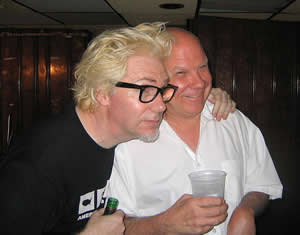 East Coast Rocker, Lunar Bear Ensemble - (self-titled): The heavy industrial collaboration includes members of some of the genre’s biggest acts, including Machine Gun, Crossfire Choir, Ministry and Killing Joke. Poet/vocalist John Ritchey, the “Lunar” of the title, brings his brand of death rant (Jim Morrison cum Suicidal Tendencies) to the project with a fiery sting. “Bear” is percussionist Richard Graham. Now for the surprising news: This recording was made one day in June, no heavy overdubbing, no stacked tracks. Just plain old industrial noise at its best. Armies of electric guitars, strength in drums of many sizes, occasional use of sound effects. – The key to Lunar Bear Ensemble is in Richey’s long-winded, desperately seeking meaning flow of words. Although its is seriously unfunny, you may find yourself chuckling quietly to “In Spite,” about alcoholics, teenagers and other unstable people. Then there’s the Zen-industrial reggae of “I Believe,” on the same spiritual plane as Lennon’s “God” but without the assertion that love will prevail. The blatantly sexual “Dark Pleasures” sounds a hell of a lot like Allen Ginsber, ranting off the words “cock balls tits” as though reading a grocery list. As a whole, the album is musically like King Crimson circa Discipline and a more restrained version of Ministry. – So maybe Rome wasn’t built in a day. Lunar Bear Ensemble were, and they did a damn convincing job of it, too. They go a bit overboard when it comes to gloom and doom overshadowing everything else, but I have yet to hear an industrial album that was completely cheery. Grope it out. – by Holly A. Ennist, Winter 1991.
East Coast Rocker, Lunar Bear Ensemble - (self-titled): The heavy industrial collaboration includes members of some of the genre’s biggest acts, including Machine Gun, Crossfire Choir, Ministry and Killing Joke. Poet/vocalist John Ritchey, the “Lunar” of the title, brings his brand of death rant (Jim Morrison cum Suicidal Tendencies) to the project with a fiery sting. “Bear” is percussionist Richard Graham. Now for the surprising news: This recording was made one day in June, no heavy overdubbing, no stacked tracks. Just plain old industrial noise at its best. Armies of electric guitars, strength in drums of many sizes, occasional use of sound effects. – The key to Lunar Bear Ensemble is in Richey’s long-winded, desperately seeking meaning flow of words. Although its is seriously unfunny, you may find yourself chuckling quietly to “In Spite,” about alcoholics, teenagers and other unstable people. Then there’s the Zen-industrial reggae of “I Believe,” on the same spiritual plane as Lennon’s “God” but without the assertion that love will prevail. The blatantly sexual “Dark Pleasures” sounds a hell of a lot like Allen Ginsber, ranting off the words “cock balls tits” as though reading a grocery list. As a whole, the album is musically like King Crimson circa Discipline and a more restrained version of Ministry. – So maybe Rome wasn’t built in a day. Lunar Bear Ensemble were, and they did a damn convincing job of it, too. They go a bit overboard when it comes to gloom and doom overshadowing everything else, but I have yet to hear an industrial album that was completely cheery. Grope it out. – by Holly A. Ennist, Winter 1991.
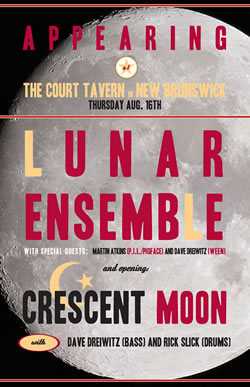 FACTSHEET FIVE #39, Lunar Bear Ensemble - (self-titled): Cool progressive rock music that pulls together raging vocals and nifty percussion and plenty of guitar and bass jamming. There’s an atmosphere of self-exploration here, of words and ideas bursting to get out, of smoke and mirrors and the madness engendered by too many late nights of though. Fine-tuned alternative rock music. (T/MG) {MA # 1081}
FACTSHEET FIVE #39, Lunar Bear Ensemble - (self-titled): Cool progressive rock music that pulls together raging vocals and nifty percussion and plenty of guitar and bass jamming. There’s an atmosphere of self-exploration here, of words and ideas bursting to get out, of smoke and mirrors and the madness engendered by too many late nights of though. Fine-tuned alternative rock music. (T/MG) {MA # 1081}
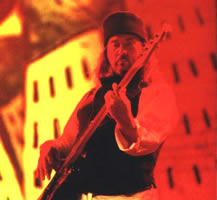 Bill Laswell
Bill Laswell
Billboard, Bill Laswell’s Greenpoint: A Golden Opportunity: The art of alchemy endures in Brooklyn. On an almost daily basis, master catalyst Bill Laswell melds disparate elements into a precious mix at his Greenpoint Studios, an informal sonic laboratory-cum-refuge where musicians and engineers are free to create without the burden of ticking clocks or other nonmusical hindrances. Forging cross-cultural synergies between musicians who might seem to have little in common, Laswell has formed a sympathetic community of singularly gifted players from around the world – from former Funkadelic keyboardist Bernie Worrell to Indian violin virtuoso Shankar, from African multi-instrumentalist Foday Musa Suso to guitar phenom Buckethead.
The musical worlds Laswell has brought together at Greenpoint collide on such mind-bending albums as Material’s “Hallucination Engine,” Nicky Skopelitis’ “Ekstasis,” and Praxis’ “Transmutation,” all recorded for Laswell’s Island distributed Axiom label.
According to Laswell, recording studios are often restrictive – even counterproductive – because the artist is paying a steep price to be there.
“You’re victimized by that reality, that you’re in someone else’s place,” he says. “When I’m (at Greenpoint), I don’t feel like I’m intruding. We have freedom, and performances happen (as if the artists were) in their own home, in an environment where they have a comfortable feeling. There’s not another session coming in; there aren’t people listening whom you don’t know.
“Ultimately, musicians are not about instruments, and making records is not about equipment,” Laswell adds. “It’s about ideas. It’s about expression.”
With his long history of working in improvisational settings both as a bassist and as a producer – playing in such incendiary post-jazz outfits as Last Exit and directing such landmark recordings as Sonny Sharrock’s “Ask The Ages” – Laswell knows how to merge spontaneous invention with studio craft without sacrificing either. The recording of “Hallucination Engine” took place intermittently over two to three years, with some players even overdubbing on parts they had cut a year two before. Like Teo Macero’s shaping of Miles Davis’ expansive studio improvisations. Laswell and his main engineers, Robert Musso and Oz Fritz, mold and mutate of-the-minute performances long after the soloists depart, realizing the recordings through creative tape manipulation.
A large, warehouse-like former rehearsal space, Greenpoint’s most distinguishing feature is the absence of a control room; the consoles and monitors are set off by 6-by-6-foot movable wall-like foam baffles.
While Laswell admits that Greenpoint’s setup is “primitive” compared to other state-of-the-art facilities, he says he dislikes control rooms because they force “a big separation between the technical side and the musical side. At Greenpoint, we’re all in the same room – and, in some cases, playing right in the engineering area. It makes communication more direct.”
“Greenpoint is less pretentious than most other studios I’ve worked in,” says Musso. “Because it’s so relaxed and open, people don’t walk in and feel like they’re on the bridge of the Starship Enterprise. So they tend to play better, and it shows on the records we make.”
Laswell and company document the proceedings at Greenpoint on 24 tracks, using two Neve 8058 consoles with type 1066 EQ. Studer A80 Mark III and RC A80 half-inch tape machines, and Sony 2500 DAT and Panasonic 3700 Pro DAT recorders. They occasionally bring in a Sony 8848 for 48-track digital remixes. The team relies on a host of outboard gear, according to Musso, particularly the Eventide H3000 harmonizer, Zoom 9030 multi-effects unit, and Akai S1000 samplers with extended memory, as well as a dbx 120X subharmonic synthesizer.
Greenpoint is used exclusively for Laswell’s productions, although sometimes he lends the studio out for favors. The only other production team to have rented the facility has been Hank Shocklee & the Bomb Squad, who worked on some of the upcoming Public Enemy record there. Laswell says he goes outside Greenpoint only for field recordings, as he did in Morocco for the Master Musicians of Jajouka’s “Apocalypse Across The Sky,” or when he has to accommodate unusually large groups, as he did on Henry Threadgill’s “Too Much Sugar For A Dime.”
The ease and economy of Greenpoint have so facilitated Laswell’s output that he has had to create offshoot labels like Subharmonic (the “Divination” ambient dub series) and Strata (“Dreamatorium” by Death Cube K, aka Buckethead) to avoid overloading Axiom. He also produces albums for such outside labels as CMP.
The newest Axiom release out of Greenpoint is Chinese vocalist Liu Sola’s “Blues In The East.” Other recent sessions have included an all-star Axiom funk project and an album featuring ambient treatments of Axiom recordings.
Thoroughly devoted to his mission, Laswell works nearly 350 days a year, including the odd tour or two, “There’s no rest, and you’re never done,” he says. – By Bradley Bambarger – May 21, 1994.
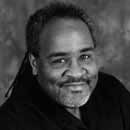 Lance Carter
Lance Carter
back to top
Jazz Times, Lance Carter (pictured), who died Nov. 1, 2006 at age 51 from the very rare and incurable bone marrow disease primary amyloidosis, was a drummer of extraordinary power and intensity. Through the ’80s, ’90s and until the moment he became physically unable to play, Carter slammed with rare authority behind the kit, fueling several cutting edge ensembles on New York’s notorious Downtown improvising scene, most notably Sonny Sharrock’s band of the early ’90s and more recently Elliott Sharp’s Terraplane. Some of those groups and several of Carter’s comrades gathered at the Knitting Factory to celebrate his memory with music that was loud, throbbing with energy and occasionally over the top with sheer abandon … just the way Lance liked it.
Opening the concert in appropriately bombastic fashion was Robert Musso & Friends, a heavy metal free-jazz ensemble fronted by the guitarist-engineer and featuring fellow guitarist Raoul Björkenheim, drummer Sim Cain, bassist Dave Dreiwitz and the skronking Philly-based tenor saxophonist/flutist Elliott Levin, a frequent collaborator with avant-alto-sax icon Marshall Allen and a longstanding member of the Cecil Taylor big band. With Sims providing whirlwind intensity on the kit, Musso stomped on his distortion box for that Sharrock-ish crunch while Levin blew with furious abandon in the midst of the fray. In their more reflective moments, Levin turned to flute and Musso used his sustaining tones in a lyrical sense, and he also pulled out the slide on a couple of occasions to summon up the spirit of Sharrock’s “shards of splintered glass” effect. This kind of sonic mayhem is definitely not for everyone. But for those who grew up with the raw tumult of Hendrix and Cream, electric Miles and the Tony Williams Lifetime and later connected with the audacious onslaughts of Sharrock and the free-spirited skronking of John Zorn, Musso & Friends provided some searing, soul-satisfying highlights.
Sons of Sharrock carried on in that same cathartic vein. Powered by former Sharrock sidemen Pheeroan akLaff on drums and Melvin Gibbs on six-string electric bass, these Sons offered up some hellacious jams in the spirit of their namesake. Guitarist Ed Cherry, a longtime sideman with Dizzy Gillespie, played with uncharacteristic grunge, dancing on an array of effects pedals while summoning up some stratospheric, blues-drenched wailing on his ax. Erik Lawrence added strong tenor playing to the mix and David Snider supplied bristled comping on keyboards. Gibbs anchored the band with his thick, low-end grooves and also offered some wicked fuzz bass solos during their brief but explosive set, which closed on a frenzied note with a raucous rendition of Sharrock’s thrashing metal boogie, “Dick Dogs.”
Gibbs also appeared with Harriet Tubman, an outstanding power trio featuring drummer J.T. Lewis and the remarkably creative but unsung guitar hero Brandon Ross, who combines the linear facility and originality of Joyous Lake-era Pat Martino with the sheer decibels and cathartic abandon of Sharrock and the liquid whammy-bar articulations of Allan Holdsworth. Ross unleashed fuzz-inflected, wah-fueled licks and testified with overdriven bluetones during this searing set, which concluded with a frantic jam that reached a Bad Brains level of intensity.
Violinist Charles Burnham, a charter member of James Blood Ulmer’s Odyssey Band, performed a stirring solo set. Performing a cappella gospel-fervor vocals, accompanying himself on percussion, or playing blues-drenched, countrified violin, Burnham offered some much-needed breath after the electrified density of the first three bands. Burnham then joined with the members of Harriet Tubman to support vocalist Cassandra Wilson on two songs—a gospel number (with Ross on banjo) and a sultry rendition of Van Morrison’s “Tupelo Honey.” Carter played on Wilson’s 1993 breakthrough Blue Note album, Blue Light ’Til Dawn. Fourteen years later, she returned (on crutches from a badly sprained ankle) to honor her fallen comrade at this moving memorial.
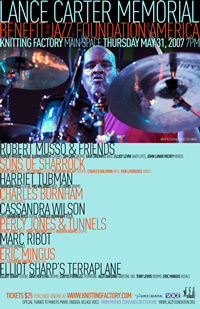 Percy Jones & Tunnels, the renegade fusion group featuring the extraordinary bassist and charter member of the British fusion band Brand X, perfectly straddled the jazz-rock divide with an energized set that put a premium on soloistic virtuosity (notably by MIDI vibist Marc Wagnon) and earthy grooves (courtesy of powerhouse drummer Walker Adams). With Jones alternately walking in blazing uptempo fashion and chording outrageously on signature pieces like “Barrio,” “Prisoners of the Knitting Factory Hallway” and “The Syzygy Incident,” Tunnels won over this audience with its freewheeling spirit and unabashed bombast (Carter appeared on the group’s live 2004 outing, The Art of Living Dangerously).
Percy Jones & Tunnels, the renegade fusion group featuring the extraordinary bassist and charter member of the British fusion band Brand X, perfectly straddled the jazz-rock divide with an energized set that put a premium on soloistic virtuosity (notably by MIDI vibist Marc Wagnon) and earthy grooves (courtesy of powerhouse drummer Walker Adams). With Jones alternately walking in blazing uptempo fashion and chording outrageously on signature pieces like “Barrio,” “Prisoners of the Knitting Factory Hallway” and “The Syzygy Incident,” Tunnels won over this audience with its freewheeling spirit and unabashed bombast (Carter appeared on the group’s live 2004 outing, The Art of Living Dangerously).
Guitarist Marc Ribot turned in some dramatic unaccompanied guitar while vocalist Meshell Ndegeocello appeared with the members of Harriet Tubman for a scintillating set of funkified jams. Charles Mingus’ son Eric performed some spoken word pieces with tenor saxophonist Catherine Sikora, then returned to join Elliott Sharp’s blues-drenched Terraplane featuring bassist Dave Hofstra, baritone saxophonist Alex Harding, trombonist Curtis Fowlkes and drummer Tony Lewis. They rocked the house into the wee hours with raucous renditions of dissonant Sharp originals like “Take My Leave,” “USA Out of NYC” and “Crackertown Two-Step.”
Live tracks from this all-star gathering will be available for download on Robert Musso’s Web site (mussomusic.com). This memorial concert also functioned as a benefit for the Jazz Foundation of America, with 100 percent of the proceeds going to this worthy organization that has been providing emergency help for jazz musicians in crisis since 1992. - By Bill Mikowski, May 31, 2007
